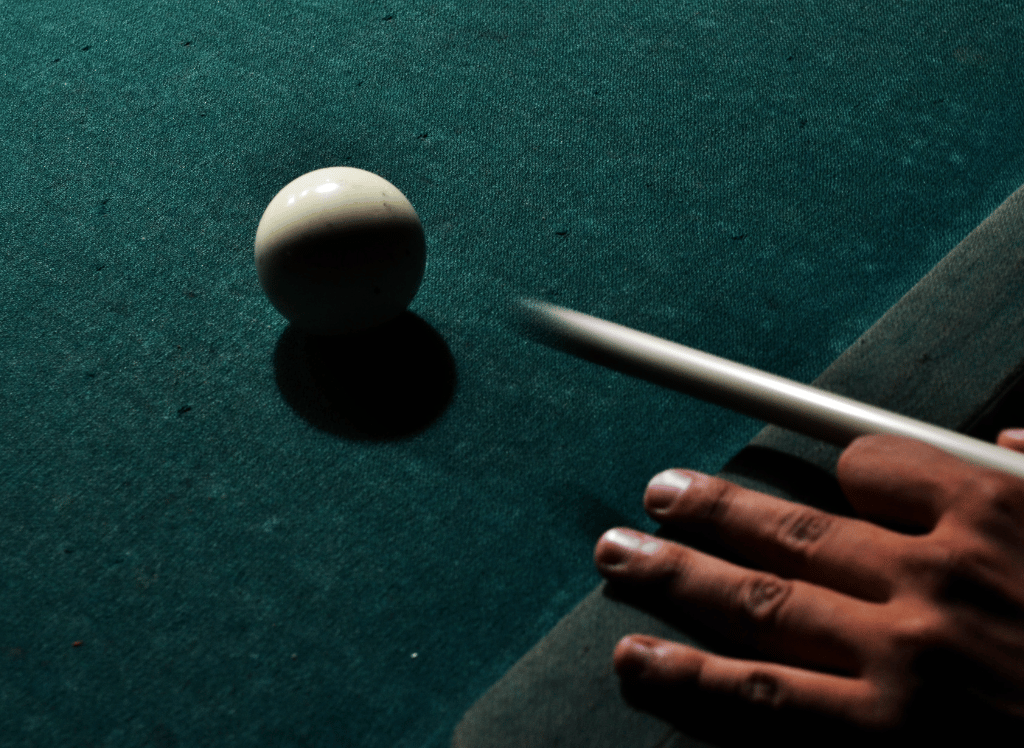Are you tired of traditional pool games and looking for a more challenging, strategic, and competitive experience? Learning how to play cutthroat brings a unique twist to billiards that will have you hooked from the start.
Understanding the Basics of Cutthroat Pool
Cutthroat pool is a game played with three or five players, where the objective is to be the last one with their assigned balls on the table. To truly excel in this game, grasp the basic concepts like the game’s main objective, the distribution of balls among players, and how to play cutthroat pool.
Game Objective
The primary goal of cutthroat is to pocket your opponents’ object balls while keeping yours on the table. In other words, you aim to eliminate your competitors by sinking their balls, while safeguarding your own set. This creates a strategic and competitive atmosphere, as players battle to outsmart one another and keep their balls in play.
The number of players affects the game’s objective, as it determines the number of opponent’s balls each player is assigned at the start of the game, including the opponents ball. No matter the number of players, the overarching aim is to be the last one standing with at least one ball on the table, while protecting your own ball.
Ball Distribution
In cutthroat, players are assigned groups of balls based on specific number ranges, each containing a unique numbered ball. For example, in a three-player game, the groups could be 1-5, 6-10, and 11-15. The groups for a five-player game can be divided as 1-3, 4-6, 7-9, 10-12, and 13-15. These groups will provide fun and exciting gameplay for everyone involved. This distribution ensures a balanced game with equal opportunities for all players.
There are different options for determining groups, such as allowing players to claim a group upon sinking a ball or having predetermined groups. No matter the method chosen, getting a grip on the ball distribution is a key factor in crafting a winning strategy in Cutthroat.
Setting Up the Table
Setting up the table properly is a prerequisite for a fair and enjoyable game of cutthroat. From racking the balls to executing the break shot, every detail counts when it comes to ensuring a balanced game that challenges all players equally.
Racking the Balls
Racking the balls in cut throat pool involves using a standard triangle rack with specific ball placements. The 1-ball should be positioned at the top (the apex) of the triangle, with the 6 and 11 balls in the corners. The remaining pool balls can be placed randomly within the rack.
A tight and proper rack is a must for a successful break shot. If the balls do not travel far after the break, it might be necessary to adjust the rack to achieve optimal results.
The Break Shot
The break shot in Cutthroat Pool requires an open break, with at least four balls contacting cushions, or else a re-rack may be requested. To achieve a legal break shot, the player must first make contact with an opponent’s ball, followed by either pocketing an opponent’s ball or having at least one ball hit a cushion.
If a player fails to perform a legal break shot, the next player can either accept the table as it is or request a re-rack and attempt the break themselves. An early advantage in the game can be gained by mastering the break shot.
Playing Cutthroat Pool: Shots and Strategies
Mastering various shots and strategies that can give you an edge over your opponents is vital to excel in Cutthroat. From legal shots to fouls and penalties, understanding the rules and nuances of the game will help you become a formidable player.
Legal Shots
A legal shot in Cutthroat Pool involves hitting an opponent’s ball first, followed by either pocketing an opponent’s ball or making contact with a cushion. This rule ensures that players focus on eliminating their opponents’ balls, rather than merely concentrating on their own set. Failure to execute a legal shot can result in penalties, such as losing your turn or having your opponent’s pocketed balls returned to the table. As the game progresses, player pockets become more crucial in determining the outcome.
Progressing in the game and keeping your opponents on their toes requires mastering legal shots, while avoiding any illegal shot.
Fouls and Penalties
In Cutthroat, fouls can occur due to illegal shots, jumping balls off the table, or other actions that result in penalties. When a player commits a foul, one of each of their opponents’ pocketed balls is returned to the table, giving their opponents a chance to recover.
Avoiding costly mistakes and ensuring fair play requires a thorough understanding of the various fouls and penalties in Cutthroat Pool. By knowing the consequences of fouls, players can make more informed decisions while executing their shots.
Scratching in Cutthroat Pool
Scratching in Cutthroat occurs when a player accidentally pockets the cue ball or jumps it off the table. The consequences of scratching include the next player receiving ‘cue ball-in-hand’ behind the head-string, with specific rules for ball placement.
After a scratch, the incoming player has the opportunity to place the cue ball anywhere behind the head string, giving them an advantageous position to execute their shot. Maintaining control of the table and staying ahead in the game requires being mindful of scratching.
Advanced Cutthroat Pool Tactics
For experienced players looking to up their game, advanced tactics can provide an edge in Cutthroat. From defensive play to shot calling, mastering these advanced techniques can help you dominate the table and outsmart your opponents.
Defensive Play
Defensive play in Cutthroat can prove to be a game-changer by making it difficult for your opponents to execute successful shots. By positioning your balls strategically and blocking your opponents’ shots, you can force them to make mistakes, giving you the upper hand.
Incorporating defensive play into your Cutthroat strategy not only protects your own balls but also disrupts your opponents’ plans. Gaining control of the table and increasing your chances of victory is dependent on mastering defensive play.
Shot Calling
Shot calling is a crucial aspect of Cutthroat that adds an extra layer of strategy to the game. Before each shot, players must designate which ball will go into which pocket. Failure to call a shot correctly can result in a foul or lost turn, making shot calling an essential skill to master.
By practicing shot calling and accurately predicting the outcome of each shot, players can gain a strategic advantage over their opponents. For advanced Cutthroat players, dictating the game’s pace and maintaining control of the table is linked to mastering shot calling.
Common Cutthroat Pool Variations
Cutthroat Pool is a versatile game that can be adapted for different numbers of players and modified rules. Understanding these variations can help you enjoy the game’s unique challenges and spice up your Cutthroat Pool sessions when you play cutthroat.
Playing with More Than Three Players
Cutthroat Pool can accommodate two to seven players by evenly splitting the object balls into sets. This variation changes the game’s dynamics, as each player has fewer balls to protect and must adjust their strategy accordingly.
The level of competition and challenge escalates when playing with more than three players, necessitating extra strategic shots and defensive play. This variation offers a fresh and exciting take on the classic game, perfect for larger groups of friends or family.
Modified Rules
Modified rules can be introduced to create unique challenges and gameplay variations in Cutthroat Pool. Some examples include:
- Adding a ‘safety’ rule
- Implementing a ‘bank the 8-ball’ rule
- Allowing players to ‘steal’ balls
- Introducing a ‘double elimination’ rule
An element of surprise and excitement can be brought to your Cutthroat Pool games by experimenting with modified rules, which pushes players to think creatively and develop new strategies. Embrace these variations and discover new ways to enjoy this engaging and competitive game.
Frequently Asked Questions
What are the rules for the cutthroat pool game?
Cutthroat Pool is a casual pool game played with three people, each of whom is assigned five numbered balls to protect. The objective of the game is to pocket the opponent's balls while avoiding having your own potted. A legal shot requires that the cue ball first contact an opponent's object ball and either pocket a numbered ball or cause any numbered ball or the cue ball to contact a cushion. The last person with one or more balls remaining on the table wins the game.
How do you set up a cutthroat pool?
To set up a cutthroat pool game, divide the table into three groups of five balls each (1-5, 6-10, and 11-15) with the 1 ball on the foot spot and 6 and 11 balls on the other two corners. Then assign each player to their respective group of balls and you're ready to go!
What happens when you scratch in cutthroat?
When a player scratches in cutthroat, they must forfeit their turn and their opponents are rewarded by being able to take one of their pocketed balls and spot it back onto the table. If none of the other players have any balls pocketed, then they simply wait for their turn.
What is the main objective in Cutthroat Pool?
The main objective of Cutthroat Pool is to be the last one with your object balls on the table, while pocketing your opponents' object balls.
What is considered a legal shot in Cutthroat Pool?
In Cutthroat Pool, a legal shot requires the shooter to hit an opponent's ball first, and then either pocket an opponent's ball or make contact with the cushion.
Summary
Cutthroat Pool is a captivating, strategic, and competitive game that challenges players to think on their feet and outwit their opponents. By mastering the basic rules, advanced tactics, and various gameplay variations, you can elevate your Cutthroat skills and enjoy countless hours of thrilling competition with friends and family. So grab your cue, rack up the balls, and dive into cutthroat pool!





